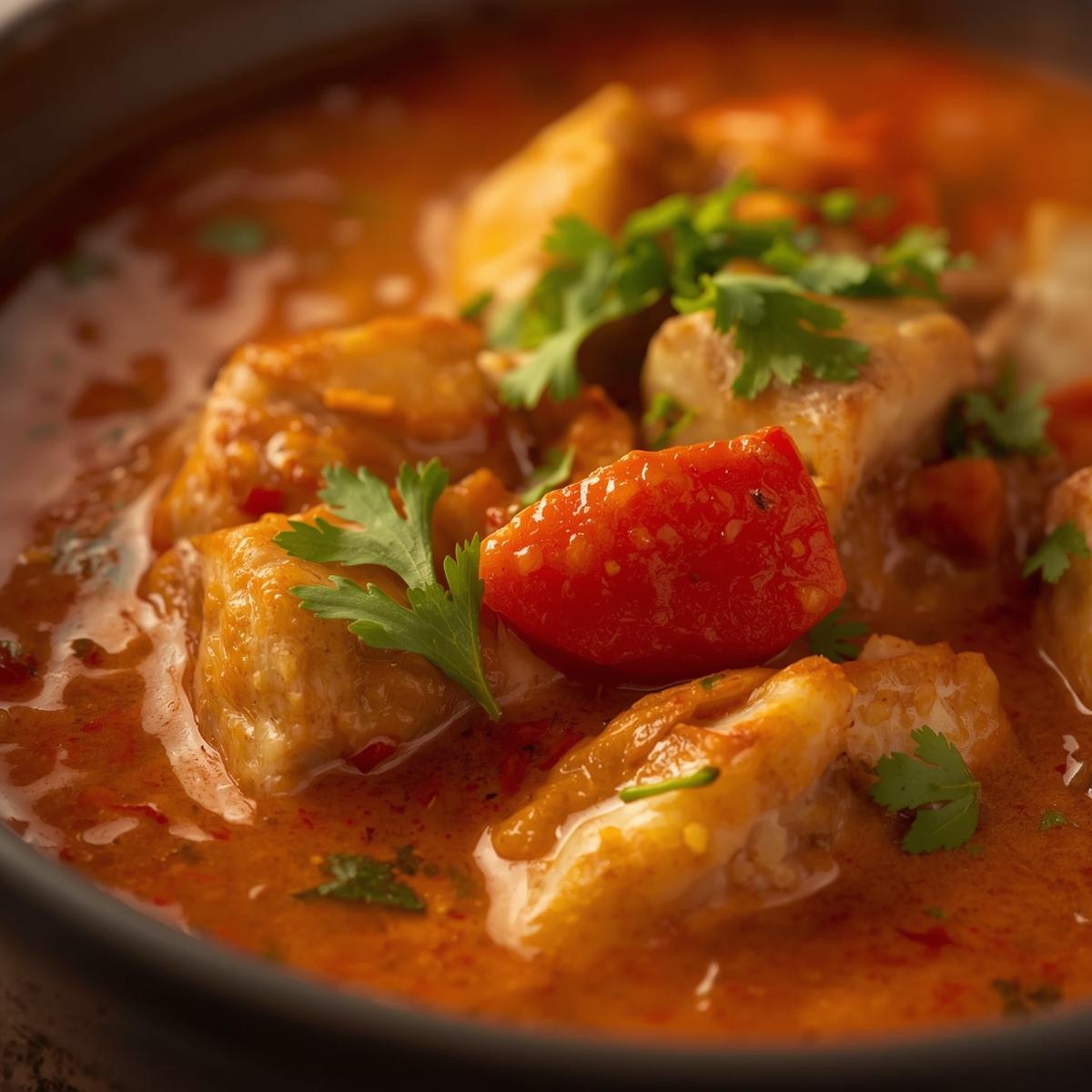Moqueca Brazilian Fish Stew with Coconut and Tomatoes
Introduction
Transport your senses to the sun-drenched coast of Brazil with Moqueca, a vibrant and soul-warming fish stew that is a celebration of color and flavor. This iconic dish is a breathtaking harmony of firm white fish, slowly simmered in a richly layered broth of creamy coconut milk, tangy tomatoes, and the distinct, earthy essence of dendê oil. It is simultaneously light and deeply satisfying, with a beautiful balance of bright, savory, and subtly sweet notes. While it tastes complex, the process is surprisingly straightforward, relying on layering ingredients rather than complicated techniques. Moqueca is perfect for a special weekend meal, a festive gathering with friends, or anytime you want to turn an ordinary dinner into a culinary event. This is a dish that feeds both the body and the spirit.
Perfect for:
A Festive Weekend Dinner
Impressively Healthy Entertaining
A Comforting yet Exotic Meal
Exploring Global Cuisines from Home
A Dairy-Free and Gluten-Free Feast
Why You’ll Love This Moqueca Recipe
An Unforgettable Flavor Experience: The combination of coconut milk, paprika, and dendê oil creates a uniquely Brazilian flavor profile that is creamy, smoky, and uniquely aromatic.
A Feast for the Eyes: With its vibrant layers of green peppers, red tomatoes, and the brilliant orange-red hue from the dendê oil, this stew is as beautiful to look at as it is delicious to eat.
Surprisingly Simple to Master: Despite its impressive presentation, Moqueca is built in a single pot with a simple layering technique. It’s difficult to get wrong and encourages a relaxed, intuitive cooking style.
Nourishing and Wholesome: Packed with lean protein, healthy fats from the coconut and dendê oil, and fresh vegetables, this stew is a truly nourishing and well-balanced meal.
Preparation and Cooking Time
Total Time: 50 minutes
Preparation Time: 20 minutes
Cooking Time: 30 minutes
Servings: 4 servings
Calories per serving: Approximately 350-400 calories
Nutritional Information (Per Serving – Estimate):
Calories: 350-400 kcal
Protein: 30g
Carbohydrates: 12g
Fat: 22g
Fiber: 3g
Sugar: 6g
Nutritional Disclaimer
aileen recipes is not a dietician or nutritionist, and any nutritional information shared is only an estimate. We recommend running the ingredients through an online nutritional calculator if you need to verify any information.
Ingredients
-
1.5 lbs firm white fish (such as cod, halibut, or sea bass), cut into large chunks
-
3 tablespoons fresh lime juice
-
3 cloves garlic, minced
-
Salt and black pepper
-
1 large onion, thinly sliced
-
1 large bell pepper (any color), thinly sliced
-
2 large tomatoes, thinly sliced
-
1 cup chopped cilantro, plus more for garnish
-
1 (13.5 oz) can full-fat coconut milk
-
2 tablespoons tomato paste
-
1 teaspoon sweet paprika
-
3 tablespoons dendê oil (palm oil), divided
-
1 fresh hot pepper (like jalapeño or serrano), sliced (optional)
Step-by-Step Instructions
-
Marinate the Fish: In a bowl, combine the fish chunks, lime juice, half of the minced garlic, and a generous pinch of salt and pepper. Gently toss to coat and set aside to marinate for 15-20 minutes.
-
Build the Stew Base: In a large, heavy-bottomed pot or Dutch oven, heat 1 tablespoon of dendê oil over medium heat. Add the sliced onion and bell pepper and sauté for 5-7 minutes, until they begin to soften.
-
Create the Flavor Layer: Add the remaining minced garlic and the tomato paste to the pot. Cook for 1 minute, stirring constantly, until fragrant. Sprinkle in the paprika and stir.
-
Layer the Ingredients: Arrange half of the sliced tomatoes and half of the chopped cilantro over the onion and pepper mixture. Carefully place the marinated fish chunks in a single layer on top.
-
Add the Liquids: Pour the coconut milk evenly over the fish. Arrange the remaining tomato slices on top. Do not stir.
-
Simmer to Perfection: Bring the stew to a very gentle simmer. Cover the pot, reduce the heat to low, and let it cook for 20-25 minutes. The stew is done when the fish is opaque and flakes easily.
-
Finish with Dendê Oil: Once cooked, remove the pot from the heat. Drizzle the remaining 2 tablespoons of dendê oil over the top and gently swirl it into the broth. Garnish with the remaining fresh cilantro and sliced hot pepper, if using.
How to Serve Moqueca
The Traditional Way: Serve the Moqueca in large, shallow bowls over a bed of steamed white rice. The rice is essential for soaking up the incredible coconut-tomato broth.
With Farofa: Offer farofa (toasted cassava flour) on the side for a traditional Brazilian touch. Its crunchy texture provides a wonderful contrast to the soft fish and creamy stew.
Alongside a Fresh Salad: A simple salad of sliced oranges, red onions, and cilantro with a lime vinaigrette provides a bright, acidic counterpoint to the rich stew.
With Crusty Bread: If you don’t have rice, a loaf of warm, crusty bread is perfect for dipping into the flavorful sauce.
Additional Tips for Moqueca
Do Not Stir After Adding the Fish: Resist the urge to stir the stew once the fish is added. This allows the fish to cook gently and evenly without breaking apart.
The Importance of Dendê Oil: Dendê oil is a key ingredient that provides an authentic, earthy flavor and vibrant color. It can be found in Latin American or international markets. If you cannot find it, increase the paprika and add a pinch of turmeric for color, but the flavor will be different.
Use Full-Fat Coconut Milk: Light coconut milk will make the broth too thin and less rich. Full-fat coconut milk provides the necessary creaminess and body.
Adjust the Heat: Control the spice level by including or omitting the seeds from the fresh hot pepper, or by adding a pinch of cayenne pepper with the paprika.
Recipe Variations of Moqueca
Moqueca de Camarão (Shrimp Moqueca): Substitute the firm white fish with 1.5 lbs of large, raw shrimp. Add them in the last 5-7 minutes of cooking to prevent them from becoming tough.
Moqueca Capixaba: This version from the state of Espírito Santo omits the coconut milk and dendê oil, using olive oil and annatto seeds for color instead. It is a lighter, more tomato-forward stew.
Seafood Medley Moqueca: Create a luxurious version by using a mix of fish, shrimp, scallops, and squid. Add the seafood in stages according to their cooking times.
Freezing and Storage for Moqueca
Storage: Allow the stew to cool completely before storing it in an airtight container in the refrigerator for up to 2 days. Reheat very gently on the stovetop over low heat to avoid curdling the coconut milk and breaking up the fish.
Freezing: Freezing is not recommended. The texture of the cooked fish and the coconut milk base can degrade significantly upon thawing, becoming watery and grainy.
FAQ Section about Moqueca
What can I use instead of dendê oil?
While not a perfect substitute, a combination of 2 tablespoons of olive oil with 1 teaspoon of paprika and a pinch of turmeric can mimic the color. The unique, earthy flavor of dendê will be missing, but the stew will still be delicious.
Can I use frozen fish?
Yes. Thaw the fish completely in the refrigerator and pat it very dry before marinating. This prevents excess water from diluting the stew.
My stew is too thin. How can I thicken it?
You can remove the fish and vegetables and simmer the broth uncovered for 5-10 minutes to reduce and thicken it. Alternatively, mash a few of the cooked tomato slices into the broth.
Is Moqueca spicy?
Traditional Moqueca is not typically very spicy. The heat level is controlled by the fresh pepper added at the end as a garnish. You can adjust this to your preference or omit it entirely.
Conclusion of Moqueca Recipe
Moqueca is more than just a recipe; it is an immersive culinary experience that brings the vibrant spirit of Brazil to your table. It proves that the most memorable dishes are often built from simple, fresh ingredients combined with care and passion. The stunning visual appeal, the complex yet harmonious flavors, and the comforting, stew-like nature make it a true showstopper. This dish is an invitation to explore, to share, and to savor. Do not be intimidated by its exotic name—embrace the process, source the key ingredients, and prepare to be amazed by the incredible meal you can create in a single pot.


